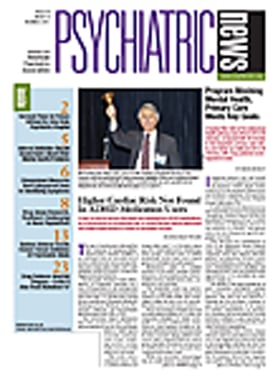Today’s adolescents have grown up clutching cell phones, “friending” on Facebook, and tweeting on Twitter, often for many hours a day.
Most of the time, there’s nothing pathological about how teenagers use electronic media, even when they spend a national average of 7.5 hours a day on those ubiquitous devices, said speakers at APA’s Institute on Psychiatric Services in San Francisco in October. However, there’s little agreement on what constitutes the boundary of “problematic” Internet use, according to Tristan Gorrindo, M.D., an assistant in psychiatry at Massachusetts General hospital and an instructor at Harvard Medical School.
Problems arise when an adolescent exhibits some combination of excessive use, lack of impulse control, and functional impairment, said Gorrindo.
The 20-item Young’s Internet Addiction Test might help clinicians decide where the boundaries lie, he suggested.
In one survey using the test, only 1 percent of adults met its criteria for Internet addiction, while 10 percent of young people did. Of that 10 percent, 41 percent also met criteria for major depression and 55 percent for lifetime substance abuse, said Gorrindo.
“Internet addiction can be seen as a harbinger of other problems, like ADHD, social phobia, depression, mania, substance use, or obsessive-compulsive disorder,” he said.
Problems also arise because young people simply don’t appreciate the harm that can befall them or others from indiscreet postings to the electronic cloud. Educating them to that reality, seeking out and treating underlying psychiatric problems, and working with parents can lessen the effects of problematic electronic behavior, concluded fellow panelist Liwei Hua, M.D., Ph.D., a clinical assis tant professor of psychiatry at the University of Michigan.
Normal adolescent social and emotional development involves separation from parents, development of personal and social identities, and an exploration of sexuality, said Hua. Those are precisely the revealing matters likely to go out on the Internet, however. In some cases, the distance created by electronic communications permits an expression of thoughts and feelings not easily done in person.
By now, the excesses of cyberbullying and online sexual predation are well known, yet many young people still find it hard to understand the consequences of revealing personal information in what seems—but often is not—a safely anonymous medium, she said.
For instance, school officials around the country get reports daily of sexting— sending suggestive or nude pictures of oneself or others—which can be the basis of felony child-pornography charges, said Gorrindo.
Given the heavy normal use of screen time by many of these “digital natives,” the information needed for a psychiatric evaluation about impairment or poor function in other domains may have to come from parents or teachers.
In light of potential hazards associated with extensive Internet and social-media use, clinicians should first strive to keep such adolescents safe, then interview them about online activity in the context of other behaviors, since they often do not volunteer information, said Hua.
Developmental age, environmental stressors, and other psychiatric conditions must be factored in, along with collateral information from parents and teachers, she said.
Massachusetts General Hospital has developed a therapeutic approach to such problematic Internet behavior, said Gorrindo. “iConnect” helps teens better understand the ramifications of online behavior and practice skills like clarifying who is and who is not a friend (without the quote marks) online. Dialectical-behavioral therapy has also been used in this process.
“The new digital divide today is between parents and kids,” he said. “So we also need to involve parents, educating them about the technology and facilitating conversations between them and their children.”


